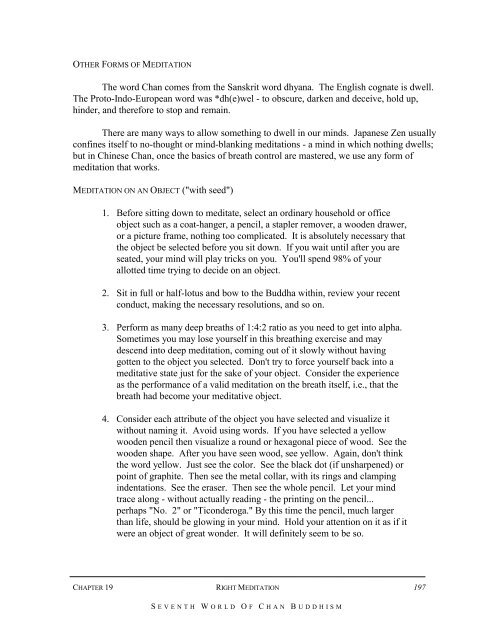seventh world of chan buddhism - Zen Buddhist Order of Hsu Yun
seventh world of chan buddhism - Zen Buddhist Order of Hsu Yun
seventh world of chan buddhism - Zen Buddhist Order of Hsu Yun
You also want an ePaper? Increase the reach of your titles
YUMPU automatically turns print PDFs into web optimized ePapers that Google loves.
OTHER FORMS OF MEDITATION<br />
The word Chan comes from the Sanskrit word dhyana. The English cognate is dwell.<br />
The Proto-Indo-European word was *dh(e)wel - to obscure, darken and deceive, hold up,<br />
hinder, and therefore to stop and remain.<br />
There are many ways to allow something to dwell in our minds. Japanese <strong>Zen</strong> usually<br />
confines itself to no-thought or mind-blanking meditations - a mind in which nothing dwells;<br />
but in Chinese Chan, once the basics <strong>of</strong> breath control are mastered, we use any form <strong>of</strong><br />
meditation that works.<br />
MEDITATION ON AN OBJECT ("with seed")<br />
1. Before sitting down to meditate, select an ordinary household or <strong>of</strong>fice<br />
object such as a coat-hanger, a pencil, a stapler remover, a wooden drawer,<br />
or a picture frame, nothing too complicated. It is absolutely necessary that<br />
the object be selected before you sit down. If you wait until after you are<br />
seated, your mind will play tricks on you. You'll spend 98% <strong>of</strong> your<br />
allotted time trying to decide on an object.<br />
2. Sit in full or half-lotus and bow to the Buddha within, review your recent<br />
conduct, making the necessary resolutions, and so on.<br />
3. Perform as many deep breaths <strong>of</strong> 1:4:2 ratio as you need to get into alpha.<br />
Sometimes you may lose yourself in this breathing exercise and may<br />
descend into deep meditation, coming out <strong>of</strong> it slowly without having<br />
gotten to the object you selected. Don't try to force yourself back into a<br />
meditative state just for the sake <strong>of</strong> your object. Consider the experience<br />
as the performance <strong>of</strong> a valid meditation on the breath itself, i.e., that the<br />
breath had become your meditative object.<br />
4. Consider each attribute <strong>of</strong> the object you have selected and visualize it<br />
without naming it. Avoid using words. If you have selected a yellow<br />
wooden pencil then visualize a round or hexagonal piece <strong>of</strong> wood. See the<br />
wooden shape. After you have seen wood, see yellow. Again, don't think<br />
the word yellow. Just see the color. See the black dot (if unsharpened) or<br />
point <strong>of</strong> graphite. Then see the metal collar, with its rings and clamping<br />
indentations. See the eraser. Then see the whole pencil. Let your mind<br />
trace along - without actually reading - the printing on the pencil...<br />
perhaps "No. 2" or "Ticonderoga." By this time the pencil, much larger<br />
than life, should be glowing in your mind. Hold your attention on it as if it<br />
were an object <strong>of</strong> great wonder. It will definitely seem to be so.<br />
CHAPTER 19 RIGHT MEDITATION<br />
S EVENTH W ORLD O F C HAN B UDDHISM<br />
197


